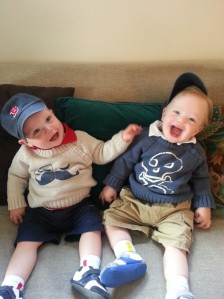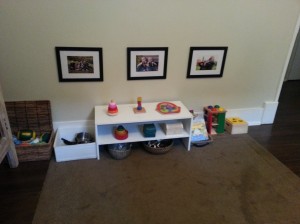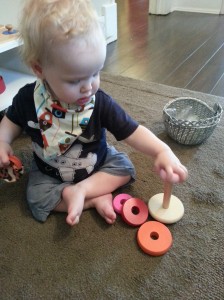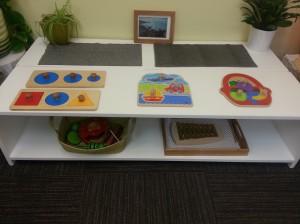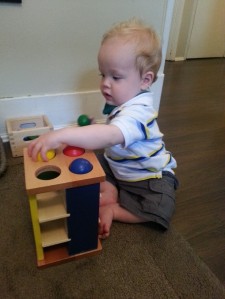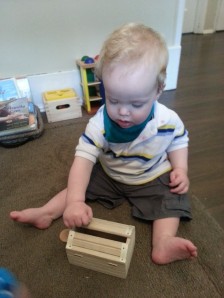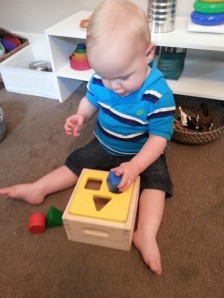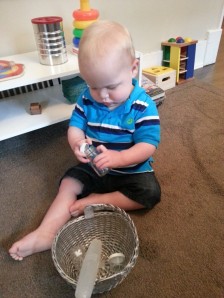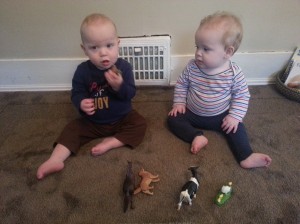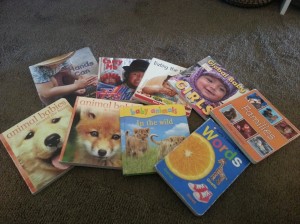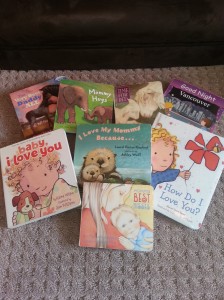At 13 months we have had a big shift in interest and R and P are loving the new activities I have put out for them.
Here is our play area – no more movement mat and mirror (since about 10 months):
Stacking Rings/Cubes:
I first introduced these activities many months ago with the series of ring stackers I have from Beginning Montessori Materials. They worked for months on just taking the rings off, then finally figured out how to put them back on. Around a year, their hand-eye coordination seemed to improve dramatically and all of a sudden they were able to work with more challenging wooden rings and cubes and take them off AND put them on.
Puzzles:
I have the shape puzzles out and they are just starting to get interested in them (as well as other simple ones that are small in size and have larger knobs).
Push Balls:
There is a fantastic one by Sapienza that I have in my classroom and it is honestly one of the children’s favourite activities for years. I tried to find one similar locally and settled on the Melissa and Doug 4 ball tower and took away the hammer. I wanted the boys to learn to exert effort with the strength of their own hand and showed them how to push the balls through.
Slotted Box with Chips:
I had an old box from Michaels Craft Store that I made into a make-shift slotted box by pulling off one of the wooden slabs and they love it. I also got the wooden chips from Michaels, and have 3 circular ones and 3 square ones. Similar to the other activities, I do always show the boys how to do the activity first and then invite them to have a turn. This is a great one for repetition and object permanence.
Mail Box:
I have the Nienhuis one in my classroom and again, wanted to find one locally for my boys at home. I settled on the Hape three shape sorter as I wanted it to be not too overwhelming with too many shapes, as well as I wanted them to be successful getting them out by themselves. I wished the lid had a hinge but they figured out how to take it off, take out a shape (seem to only take one out at a time), put back the lid and then attempt to put the shape in. If I am sitting with them I remove the lid, take out all the shapes, and then put the lid back on for them.
Opening and Closing Containers:
Another favourite! I collect bottles always when I am on vacation from hotels, etc., then wash them out and use them in my classroom and now at home. I put together a collection of about 10 different ones (also use the travel containers you can buy at any local drugstore) in a basket and show how to ‘turn’ the lids on and off. They definitely love this one (haven’t quite figured out how to turn their wrists yet) but once the lid is off, like putting it on and off.
Basket of Animals:
Since R and P seem to be craving language and want to know the names of EVERYTHING, this basket seems like a necessary activity. The difference in this is that when we introduce language objects, an adult always should be present to offer the child the right names. So it is very much an adult directed activity (naming each animal, letting them hold it, and then asking for certain ones “Where is the duck?”). This also has been a great activity as they love to take things out and put things in baskets/cupboards/drawers/etc. so we always put the animals back in the basket when done.
Basket of Balls:
This basket is a saviour! Not only are they loving to throw and chase after these balls, but it gives them an outlet as they love to throw. Their mind is now telling them, I can control my body. I know how to grasp, pick up, etc and now I want to exert my effort. In the beginning they don’t know the boundaries of what is ok to throw and what isn’t, so this is where we need to be the positive role model. Many times a day I say things such as, “The bottle is not for throwing. We throw the balls.” And then I pass them a ball to throw. I am not joking that the last time I said that, P went HIMSELF to the basket, picked up his own ball, threw it, then smiled at me! They understand SO much without being able to speak and we must remember this.
Books:
We cannot forget the books! The boys LOVE their basket of books (which I rotate every few weeks) and choose to look at these often. They take one from the basket, put it in front of them and know how to flip through the pages. The majority of the time they will pick up a book at pass it to me with an “aadddaa?” Meaning, read this to me please?
We have another collection of more ‘story-type’ books in their bedroom that we read before naptime and bedtime (both R and P get to pick one that he would like me to read).
What’s on your play shelf that your child really enjoys right now?

